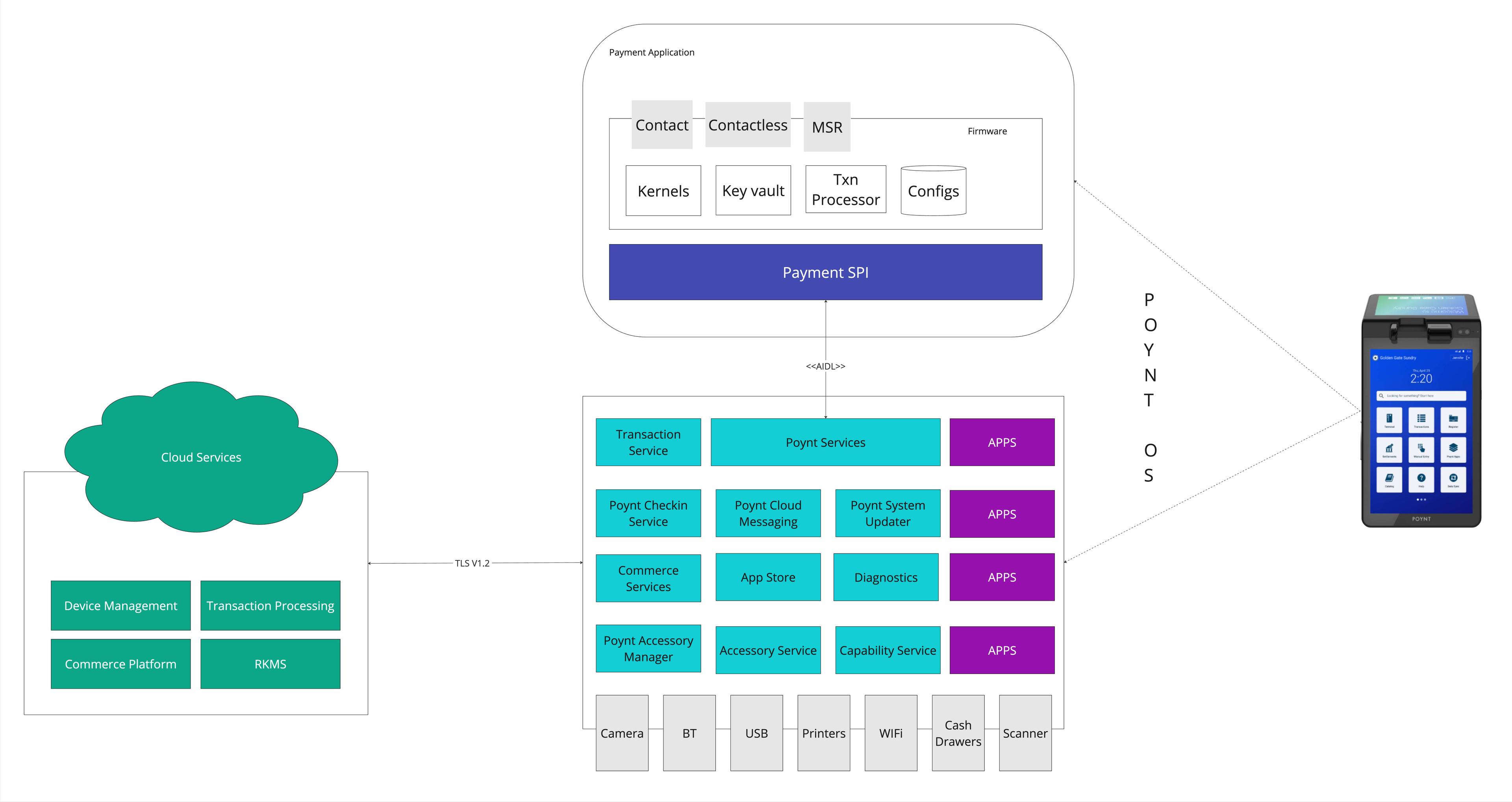Key takeaways
- Poynt OS provides a unified, hardware-agnostic platform for managing payment systems and commerce operations at scale.
- The architecture uses AIDL-based SDKs and standardized interfaces to enable seamless integration with various hardware manufacturers and third-party developers.
- The platform combines secure payment processing with robust device management capabilities to support global operations.
In an era where seamless payment systems are critical for businesses, the need for a unified and flexible platform has never been greater. The rise of omnichannel commerce has highlighted the importance of providing merchants with solutions that unify payment methods, streamline operations, and enhance customer experiences. Recognizing these challenges, we wanted to build an operating system that powers an open commerce platform designed to bridge the gap between diverse hardware, third-party developers, and evolving merchant needs.
This post provides a high-level overview of the architecture that drives Poynt OS, offering insights into its core components and design principles. In subsequent posts, we will delve deeper into specific aspects of the platform, including SDKs, system services, and the cloud ecosystem that powers it.
Goals of the Poynt OS architecture
Traditional payment terminals often require hardware-specific solutions for managing device systems, firmware, and payment applications. This fragmentation hinders scalability and innovation. Poynt OS addresses this by standardizing payment processing and device management through public SDKs, enabling developers and hardware manufacturers to build solutions that integrate seamlessly with the platform. To address the unique challenges of modern commerce, Poynt OS architecture had the following goals:
- Unified Ecosystem: Create a platform that seamlessly connects merchants, resellers, and developers.
- Efficient Device Management: Manage a large fleet of smart payment terminals globally with secure and scalable tools.
- Hardware-Agnostic Integration: Enable compatibility with smart payment terminals, irrespective of the hardware manufacturer.
Architecture overview
The following diagram and table illustrates the three key layers of the Poynt OS architecture and the key components:

The Poynt OS architecture consists of five fundamental layers: AIDL-based SDKs, system services, the payment application, merchant apps, and the cloud platform. These layers work together to enable seamless commerce and payment experiences. System services handle core Android OS operations, while the payment application manages secure firmware operations, including EMV-based card processing. Merchant apps interact with payment services via AIDL-based SDKs, and the cloud platform facilitates transaction processing, identity services, and fleet management.
| Component | Description |
|---|---|
| Secure Firmware | Handles secure operations like key vault management, kernel updates, EMV configurations, and transaction processing. |
| Commerce Services | Provides tools for catalogs, inventory, orders, and pricing, exposing functionality via Android Interface Definition Language (AIDL)-based Commerce SDK. |
| Transaction Service | Manages transaction processing, including voids and refunds, either directly or through the cloud platform. |
| Poynt System Updater | Enables secure OTA updates for OS, firmware, and applications. |
| Poynt Checkin Service | Collects logs, bug reports, and health metrics for real-time device monitoring and issue detection. |
| Poynt Cloud Messaging | Facilitates server-initiated messages for device management and commerce operations. |
| Diagnostics | Provides merchants with tools for network checks, troubleshooting, and bug report submissions. |
| Poynt App Store | A marketplace for developers to build and distribute payment and commerce applications. |
| Vendor SDK | Exposes tools for hardware OEMs to integrate with Poynt OS via standardized Payment SPI APIs. |
| Board Support Package | Provides OEMs with guidelines for secure and seamless integration, including SELinux policies and signature permissions. |
| Poynt OS SDK | Offers APIs for developers to build apps with features like loyalty, catalogs, inventory, and accessory management. |
Broader pieces driving this architecture are AIDL based SDK services implemented by payment applications and in some cases, the third-party applications and OEMs. There are also core system services that run on system apps and OS that drive the device management aspects of this. Additionally, the cloud platform manages transactions, device management, identity and commerce services.
- AIDL-Based SDKs: These SDKs (Poynt OS SDK and Vendor SDK) expose Android-bound services, allowing developers and hardware manufacturers to implement payment and commerce functionalities. For instance, developers can create loyalty programs, catalog solutions, or printer integrations while seamlessly integrating payment hooks into the Poynt OS ecosystem.
- System Services: Customized Android OS services enable device management tasks such as check-ins, OTA updates, and fleet monitoring. These services form the backbone for managing devices at scale.
- Cloud Platform: The cloud layer handles transaction processing and device management. It ensures secure payment authorization, OTA updates, and real-time diagnostics, providing scalability for global operations.
The Poynt OS simplifies commerce by bringing all of the commerce functions required by businesses under a single OS. While many functions work out of the box, we've built the OS to be extensible and able to work with different integrations. The following examples show some of the integration possibilities.
Example: 3rd party app integration
Any 3rd party app in the Poynt OS ecosystem can use Poynt SDK to initiate the payment flow on the platform via Poynt SDK APIs, driving the payment experience. The app dynamically manages dual displays, showing the merchant's interface on the primary screen and customer interactions on a secondary screen.

Example: Hardware vendor integration
Third-party hardware vendors often provide two key integration components: first, the card reader for payment processing, and second, the board support package modifications at the OS level for seamless integration with device management applications.
Card reader integration
The Payment SPI (Service Provider Interface) defines functional APIs designed to enable quick and easy integration of underlying card reader functionality into the payment experience and applications built for Android OS.
The SPI implementation must be an AIDL service that implements the functionality defined in the Payment SPI and Payment Security SPI AIDL interfaces, which are part of the Vendor SDK. The APIs under the Vendor SDK fall into the following categories:
- Transactional APIs: Support various aspects of processing card-based transactions.
- Security APIs: Support loading PIN and data encryption keys into the secure firmware.
This is how third-party hardware can update the payment actions as users interact with card reader and send necessary UI events and responses to the payment application in the Poynt OS. Following is an example code snippet:
@Override
public void startTransaction(CardReaderRequest parameters, IPoyntPaymentSPIListener callback)
throws RemoteException {
// Internal firmware protocol that vendors use to start a transaction
firmware.startTransaction(parameters);
// Notify Payment Application (managed by GoDaddy) to update the UI
callback.onEvent(PRESENT_CARD);
// Send back response for this startTransaction() request,
callback.onOnlineAuthorizationRequired(cardReaderResponse);
}Device management integration
As an example. the vendors will need to modify the Android OS code to grant some special access to Poynt OS system apps with POYNT_UID. This allows services to start in the background that will be useful for performing things like OTA updates, accessory management, or second screen services.
--- a/core/java/android/app/ActivityManager.java
+++ b/core/java/android/app/ActivityManager.java
@@ -2660,7 +2660,8 @@
int owningUid, boolean exported) {
// Root, system server get to do everything.
final int appId = UserHandle.getAppId(uid);
- if (appId == Process.ROOT_UID || appId == Process.SYSTEM_UID) {
+ if (appId == Process.ROOT_UID || appId == Process.POYNT_UID
+ || appId == Process.SYSTEM_UID) {
return PackageManager.PERMISSION_GRANTED;
}
// Isolated processes don't get any permissions.
By modifying the Android OS code to grant special access to Poynt OS system apps with POYNT_UID, vendors can simplify integration and make it hardware-agnostic. This ensures that the Poynt OS commerce and payment platform does not depend on hardware-specific firmware protocols chosen by manufacturers, nor does it interact with the underlying hardware access layer from the OS. Similarly, for card reader integration, the Payment SPI abstracts direct interaction with proprietary firmware by defining a standard interface for transaction processing and security operations. Vendors only need to implement an AIDL-based service within the Vendor SDK, ensuring that card reader firmware variations do not impact the overall payment experience. This approach enables us to expand our reach by powering any payment hardware worldwide with GoDaddy's commerce platform.
Summary
The Poynt OS became the first operating system for commerce by providing a single ecosystem for merchants, resellers, and developers. Using a single, comprehensive OS helped us simplify transaction processing with pre-integrated acquirers and strong device management out of the box. Overcoming the challenges of compliance certification, security standards, and backward compatibility, Poynt OS provides a seamless experience for merchants and customers. Poynt OS, when combined with its suite of services, including Payment SPI, Commerce Services, and the Poynt App, enables a host of innovations around omnichannel commerce while creating superior experiences. These systems today help GoDaddy process over $25 billion in payment volume across more than 300,000 payment terminals all around the globe. In subsequent posts we will explore a few key optimizations we did in our fleet management that help us roll out software more effectively to all our devices at scale.






